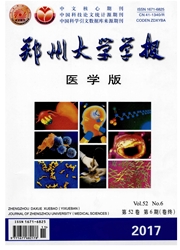

 中文摘要:
中文摘要:
目的:应用倾向指数匹配法均衡组间的协变量,评价单纯应用放疗( CRT )与三维适形放疗联合化疗( CCRT)对局限期小细胞肺癌( LD-SCLC)的治疗效果。方法:LD-SCLC患者224例,其中CRT 109例,CCRT 115例。基线资料包括性别(1=男,0=女)、年龄、吸烟(1=是,2=否)、结核(1=有,2=无)、家族史(1=有,2=无)、TNM分期(1=Ⅰ期,2=Ⅱ期,3=ⅢA期,4=ⅢB期)、血清神经元特异性烯醇化酶(NSE)水平、KPS评分、肿瘤数量(1=单个,2=多个)等。以分组变量为因变量,以协变量为自变量,建立logistic回归模型,计算倾向指数,然后按照倾向指数进行组间卡钳匹配。分别对匹配前后的数据进行生存分析。结果:匹配前CRT组和CCRT组的中位生存期(95%置信区间)分别为2.15(1.96~2.48)和2.37(2.06~2.72) a,1 a生存率分别为82.65%和83.36%,2 a生存率分别为59.02%和64.30%,3 a生存率分别为25.28%和29.34%,两组生存曲线差异无统计学差异(χ2=2.173, P=0.186)。两组共94对匹配成功。匹配后CRT组和CCRT组的中位生存期(95%置信区间)分别为2.14(1.75~2.44)和2.75(2.38~2.92) a,1 a生存率分别为82.24%和85.36%,2 a生存率分别为56.39%和66.20%,3 a生存率分别为23.44%和34.37%,两组生存曲线差异有统计学意义(χ2=11.045,P=0.008)。结论:采用倾向指数匹配法能有效降低非随机化临床试验数据的混杂偏倚。
 英文摘要:
英文摘要:
Aim: To compare the effects of single chemotherapy ( CRT ) and conformal radiotherapy combined with chemotherapy(CCRT) on limited disease small cell lung cancer (LD-SCLC) patients after balancing the covariates by pro-pensity score .Methods:A total of 224 LD-SCLC patients were subjected ,among which ,109 accepted CRT , and 115 ac-cepted CCRT .A logistic regression model was established ,and the treatment assignment was taken as the dependent varia-ble and the covariates as the independent variables .For each LD-SCLC patient , the propensity score was calculated for cal-iper matching and a survival analysis of the matched data was carried out .Results: Before matching , the median survival time (95%CI) of CRT and CCRT were 2.15(1.96-2.48) and 2.37(2.06-2.72) years,respectively;one-, two-, and three-year survival rates were 82.65%and 83.36%, 59.02% and 64.30%,25.28% and 29.34%, respectively.There was no significant difference in survival curve between the two groups (χ2 =2.173,P=0.186).A total of 94 pairs patients were matched by propensity score .After matching, the median survival time(95%CI) of CRT and CCRT were 2.14(1.75-2.44) and 2.75(2.38-2.92) years;One-, two-, and three-year survival rates were 82.24%and 85.36%, 56.39%and 66.20%, 23.44%and 34.37%, respectively.There was a significant difference in survival curve between the two groups (χ2 =11.045,P=0.008).Conclusion: Propensity score matching can effectively reduce the confounding bias of non-randomized clinical observational data .
 同期刊论文项目
同期刊论文项目
 同项目期刊论文
同项目期刊论文
 Study on capsular serotype of Klebsiella pneumoniae from patients with liver abscesses and its clini
Study on capsular serotype of Klebsiella pneumoniae from patients with liver abscesses and its clini 期刊信息
期刊信息
